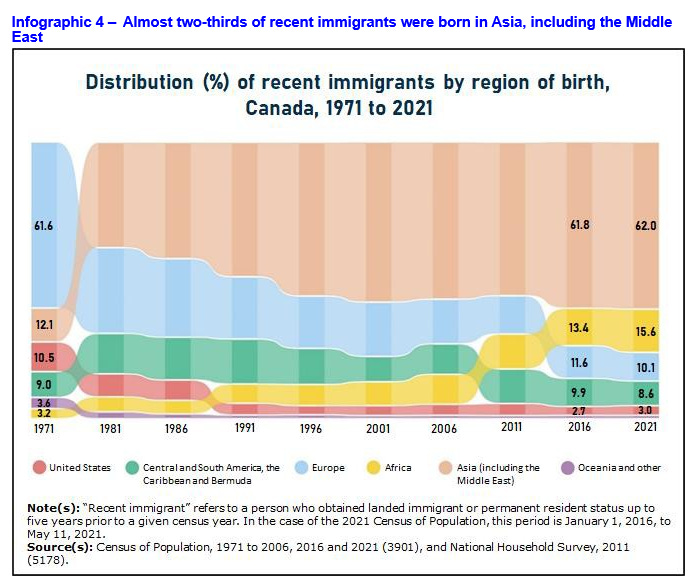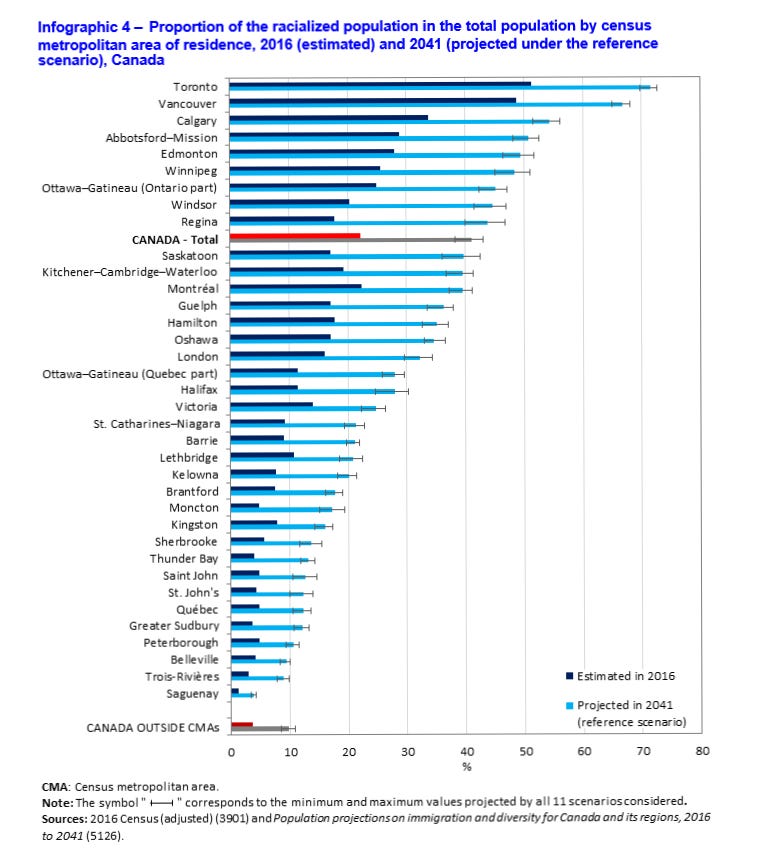Mass immigration: The transformation of Canada
Immigration shapes a nation. Mass immigration transforms a nation.
Canada, under the Liberal Party, has one of the most aggressive immigration policies in the world. In fact, we haven’t had a larger share of the population as immigrants in over 100 years and with around a 500,000 yearly target we are just getting started.
In 2022 Canada welcomed 437,120 new permanent residents. 75,330 of them were refugees. 2022 immigration numbers exceeded the target by just over 5,000 people setting a new record and surpassing 2021’s immigration record which had the highest immigration level since 1913.
Canada’s 2022 immigration origin by country: India 27%, China 7.2%, Afghanistan 5.4%, Nigeria 5.05%, Philippines 5.04%, France 3.2%, Pakistan 2.6%, Iran 2.5%, US 2.3%, and Syria 1.9%.
From 2016 to 2021 over 1.3 million new immigrants settled permanently in the country. 218,430 of them were refugees. I will use these years’ numbers as they have complete census data. 2022’s numbers actually seem to accelerate the findings.
In 2021 more than 8.3 million people were landed or permanent residents. That equals to 23% of the population and the highest proportion among the G7.
Over the last few decades, the majority of immigration into Canada originated from Europe and over time it transitioned to Asia, Middle East, and Africa as the source.
62% of recent immigrants’ birthplace was in Asia and the Middle East. 18.6% of that are from India followed by Philippines at 11.4% and China with 8.9%. Europe as a whole accounted for just 10.1% of immigrants’ birthplace in 2021.
Canada’s society will look different in the future.
From 2016 to 2041 the average growth rate of racialized (what the government refers to as those who are not white) population would be between 2.9% and 4.2% compared to the Canadian population of 0.7% and 1.5%.
By 2041 up to 34% of the population will be immigrants. 1 in 4 will be born in Asia or Africa. 2 in 5 Canadians will be from a racialized group. Black population will surpass the Chinese and Indigenous populations.
Racialized population will be the majority in Winnipeg, Edmonton, Abbotsford-Mission, Calgary, Vancouver, and Toronto.
In most of Canada’s major cities, white people will become a minority, and that trend will be more evident in classrooms first. That’s just in 18 years and the ‘trend’ will continue. Compared to the generalized, over-encompassing, term: racialized.
The influx of immigrants into concentrated areas will transform needs and consumption. Real estate is where most of the impact has been so far, maybe not to the realization of many Canadians. I will write a separate article with a focus on the economic side.
The cultural divide, in every sense of the word, between urban and rural Canada will be at its greatest point and continue to diverge. It will be ‘old stock Canadians’ in rural areas and ‘new Canadians’ in urban areas.
I suspect race and cultural-based political pandering will only accelerate as politicians try to capture votes within specific concentration areas. What started provisionary will soon enough be transitional, and with Canada’s changing demographics, permanent.
The concentration of religious and cultural similarities will attract and lead to a critical mass of people in areas. As we are in a democracy ‘critical mass’ can and will transform policy. in one direction or another.
Pandering equals ignorance. There are plenty of examples of that from the UK, and Sweden. Notice that there are no drag shows hosted in certain areas, either.
The cultural diversity in Canada is a beautiful thing. But navigating Canada’s transformation will require a move from identity-based politics and policy to unity. To avoid fractionalism there must be assimilation - a politically scary word outside of Quebec to a certain extent.
Assimilation not at the cost or expense of people’s culture but also not at the lack of Canada’s unity.
What is Canada? That is a question that we need to answer. What is our culture? What are our values? What is our future?



